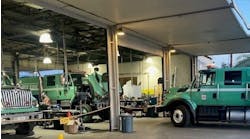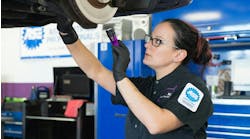Shops adopt new strategies to overcome industry challenges at Diesel Connect
PHOENIX—Economic uncertainty, rising costs, and the technician shortage are creating challenges for maintenance providers, but shop owners are remaining focused, increasing efficiency, and utilizing technology to optimize operations. This was evident at the Diesel Connect, a brand-new conference set up by shop management solution provider Fullbay and held in June.
“Overall, most of the shop owners have good programs in place,” acknowledged Fullbay COO Chris O’Brien, who was also a speaker at the event. “They’re following great discipline. They are using a lot of material online or that we’ve published. They are running financials and quarterly reviews and that is keeping things running.”
Attendees said data and information have been a critical part of finding solutions to industry obstacles and meeting fleets’ needs.
“I’m a firm believer in managing by the numbers,” said Luke Todd, president of The Service Company. He added that using data ensures he and his managers are on the same page. “I know what we need, and they know what we need.”
Reviewing information helps shop operators determine where to focus their efforts. Chris Barnhardt, vice president of operations for RWBT Inc. dba Southeast Fleet Services, runs reports to determine the most profitable work.
“I know exactly what jobs I want to do now and what jobs I don’t want to do,” he said.
Jan Kettle, director of business operations, Quality Mobile Fleet Services, uses reports to prioritize relationships. “I want to look at who my top customers are, how much are they spending, if their numbers are going up or down by period, and how can we support them better,” she said.
Increased costs
Shop operators faced their own internal economic difficulties, as the price of parts and labor costs rise. This has forced shops to raise their own prices, which is a difficult conversation for shops to have with customers. But the action is necessary.
"You have to stay in business for the good of the industry, and that might mean raising prices in the environment we're in today," explained Jacob Findlay, executive chairman and founder of Fullbay.
Last year, Stacy Conner, president of Equipment Experts, Inc., had three price increases based on the wages in the area.
"All of the techs were leaving Washington,” she said. “To get and retain them, we had to raise what we were offering everybody.”
Brad Bost, CEO at RWBT Inc. dba Southeast Fleet Services, said hard numbers helps substantiate cost increases to customers.
“If a cost goes up significantly, say workman’s comp or insurance, we can plug it in and then see if we need to raise our labor to cover these costs. Then, we’re going to have the means to justify that increase to our customers versus just telling them it went up,” he said.
Finding and retaining technicians is an ongoing challenge, and salaries must be competitive.
“It can’t be a gut feeling," said Jay Goninen, president of WrenchWay. “This is something you have to keep your finger on right now because of how competitive the market is. It is a numbers game. There aren’t enough people to fill the positions out there.”
Roughly 5% of technicians are constantly on the job hunt, and 75% are open to new opportunities, Goninen said.
"We’ve created this wild west of technicians that are jumping around,” he explained. "Being proactive and doing something different to create a pipeline into our shops is what we need to do going forward.”
Goninen told attendees that 40% of technicians agree that pay structure is the most important thing that needs to be fixed to combat the technician shortage. However, benefits, flexible scheduling, and a positive work environment are also priorities for prospective employees. Plus, technicians are increasingly interested in their career path and not just when getting started.
“What about that career tech who is 55 and their body is breaking down? Maybe you turn them into a trainer or a quality control person in your shop,” he said.
To help maximize labor, Troy Willich, president of TDI Fleet, focuses on efficiency and utilization and runs regular reports.
“It is probably the most important thing we use to see if there is any problem with any part of the operation,” he said, adding that if there are problems, he'll take time to watch technicians work. “If you watch long enough, you’ll figure out what is going on with those inefficiencies.”
Limited supplies
Chase Bowman, vice president of operations for AM PM Diesel Services, said everyone understands there is a technician shortage, but other critical equipment is also in short supply. He is having a hard time finding service trucks.
Finding new locations for shops can also be a challenge. "The industrial zoned areas are difficult to come by, and the cost of locations and leases is exorbitant," Connor said.
Parts availability remains a concern, and several operators said they’ve increased their inventory levels. “We have seen our inventory values rise over the last couple of years,” Todd explained.
When hard-to-find parts, such as brake drums and shoes, came available, Todd would stock up, even buying a trailer load of brake drums. “I’d rather have parts than good turns,” he said.
Austin White, co-owner of JE-CO, said his employees constantly inquire about parts availability with suppliers. "When three people tell us there is about to be a shortage, we take it seriously and start stocking up," he said.
At one point, White spent $40,000 on filters. “We are just barely at the point we can get them again,” he said.
Keith McMaster, president of Fireweed Heavy Truck and Equipment Repairs, regularly runs inventory management reports to review parts sold, historic demand, costs, and potential shortages. With Fullbay, he can also compare parts he has in stock with their current market value, which has shifted drastically due to market dynamics, and create a cost floor. “I may have bought it for $5, but now it is selling for $100,” he said. “You can sell it for the new cost floor plus your margin.”
Economic factors
While the economy has created concerns for the maintenance industry, it is also helping to boost demand for their services.
"This industry is sort of counter-cyclical," said Findlay said. “Fleets are running trucks that aren’t under warranty now. In a slowdown, that might increase your workload in some ways.”
During the conference, Jonathan Starks, CEO of FTR Transportation Intelligence, said several economic indicators, including personal consumption expenditures and manufacturing output, are remaining stable.
“We believe there is some stability in the economy, and we can stay out of a recession even though there are some substantial risks,” he said, adding that it is important to monitor consumer spending. “The consumer drives the economy. Understanding their behavior is critical to understanding the potential of the economy to stay strong or go into a recession.”
Starks said changes in inventory levels, which drive velocity, could also affect trucking demand. “If sales ease, you get a double impact of the loss of the sale and the loss of inventory,” he said.
The financial markets pose the greatest risk to the economy. “Consumer and construction risks have begun to minimize, but this is the one that could explode,” Starks said.
A look ahead
The regulatory industry and new equipment requirements are likely to shape service needs going forward. Findlay expects to see a diversity of powertrains but said that won't eliminate the need for maintenance providers.
"Worst case scenario, they still need work done even if it isn’t a diesel powertrain,” he said.
O’Brien noted that electric vehicles are hard on tires, which could create new opportunities for shops.
Technology will also take on greater importance, especially as OEs do more to incentivize customers to go to the dealership. Fullbay CEO Patrick McKittrick recommended shop operators adopt tools to streamline and enhance customer communication.
Overcoming these challenges comes down to shop owners answering one simple question, according to McKittrick: “What can you do as a business to service that customer better than if they went to a dealer?”




